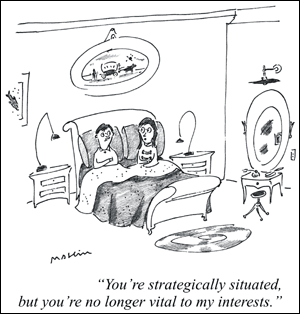Chapter 14
Our Traditional Methods of Preventing War
and Maintaining Peace Do Not Work
“Tradition is the illusion of permanence.”
—Woody Allen
The absence of war is not peace, and real peace is not achieved through armed conflict. The victor dominates and the loser submits; it is a forced armistice. After enough blood is shed, the fatigued combatants grow tired of fighting. Their cause begins to lose focus as they begin to long for peace, so they finally quit fighting and go home. Sometimes they even draft a treaty. Calm lasts for a while, but eventually their cause comes back into sharper focus than their desire for peace, so hostilities resume—especially when a new generation, unfamiliar with war, desires revenge. It's a vicious cycle, extremely costly in both human lives and in resources. War is an inefficient “source” of peace.
Treaties and resulting obligations are effective only as long as the parties involved choose to honor them. Consequently, treaties are political, temporary, and hard to enforce. They have been broken in order to start wars. One or more parties to the treaty may have entered into it in bad faith just to gain an advantage. By contrast, within most countries, a contract is a legally enforceable instrument, which carries legal repercussions if broken. However, no such enforceable remedy exists under international law for breach of treaty. Without the force of law, treaties are of little or no consequence. Can you imagine what the world economy would be like if contracts were not enforceable? Mortgages, business agreements, and marriage contracts would mean nothing.
The problem with disarmament treaties in particular is that one country has to disarm first. Who would want to be unprotected against other nations that may be dishonest and keep a few hidden weapons—just in case? No one—that’s why disarmament and non-proliferation treaties are ineffective.
Alliances and Balance of Power

© The New Yorker Collection 1997
Michael Maslin from cartoonbank.com
All Rights Reserved.
At the beginning of the 20th Century, peace in Europe was maintained by a tangled web of alliances between the major nations. The alliances were meant to balance power as a means of deterring aggression. If any nation were to disturb that balance, other nations would oppose it as an alliance.
The alliances designed to maintain peace became the structure of a bonfire we now know as World War I. The spark that ignited the blaze was a relatively insignificant event. Archduke Franz Ferdinand, heir to the Austro-Hungarian throne, was assassinated by Serbian nationalists in Sarajevo. Four years later, 20 million people had died fighting for their nations’ interests. World War I was then thought to be the “war to end all wars” but, as we know nearly a century later, it was not.
International Governmental Organizations
In the last few centuries, nations have met four times in an attempt to re-order the world.
- The Peace of Westphalia in 1648, which ended the Thirty Years War, having claimed 5 to 10 million lives.
- The Congress of Vienna met in 1815, after the Napoleonic Wars claimed 3 million lives.
- World War I broke down the Concert of Europe and claimed 20 million lives. Nations met again in 1919 in Paris. They adopted the Treaty of Versailles and established the League of Nations. It disbanded after failing to prevent World War II.
- World War II took 50 million lives. In 1945, the victorious nations met in San Francisco. They founded the United Nations and formed the International Court of Justice. However, there have been about 177 armed conflicts resulting in more than 54,000,000 deaths since 1945. (Appendix B)
|
|
NATO (North Atlantic Treaty Organization) is another International Governmental Organization (IGO) formed under treaty in 1949. NATO reaffirms the UN Charter and serves as an alliance to provide for a collective defense. However, NATO cannot prevent war; it merely provides for retaliation.
The Folly of Deterrence
The Chinese invented the crossbow in the Seventh Century B.C.E. It was used in Europe by the ancient Greeks and Romans. However, religious leaders like Pope Urban II in 1097 and later Pope Innocent II banned them. But the crossbow’s effectiveness against the Turks in the Crusades soon prevailed over any theological concerns.
Gunpowder, also invented in China, was originally used for fireworks. It was adapted to bombs, rockets, guns, and cannons, which replaced the catapult, battering ram, and archers.
In 1861, Dr. Richard Gatling patented the Gatling Gun, a six-barreled weapon capable of firing an incredible 4 bullets per second. Gatling sincerely believed that his invention would end war by making it unthinkable due to the horrific carnage it was capable of producing.
“On the day that two army corps can mutually annihilate each
other in a second, all civilized nations will surely recoil with
horror and disband their troops.” [1]
—Alfred Nobel, 1891
Nobel was referring to his invention, dynamite. He dreamed that war would be impossible with weapons as terrible as dynamite. Despite Nobel’s brilliance, he overestimated man’s sensibility. Since that time, man has created and used biological, chemical, and nuclear weapons—far more terrible than dynamite-none of which has deterred war.
[1]Sven Tagil, Nobelprize.org, “War and Peace in the Thinking of Alfred Nobel,”
http://nobelprize.org/nobel/alfred-nobel/biographical/tagil/. December 25, 2005.